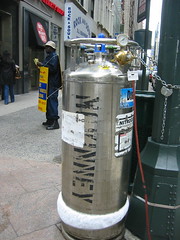»The Works: The Anatomy of a City
Kate Ascher of the New York City Economic Development Corporation has written the entirely fascinating and very useful The Works: The Anatomy of a City, which takes the components of a city — New York, in this case — and presents their relationship to each other and to the people of the city; and their role in the massive system that makes up a growing urban area. The transportation, from sidewalks to subways; the utility systems, answering the question "What happens when you turn the tap on a hot-water faucet?"; the bridges and tunnels, which bring vast quantities of New Jersey twentysomethings^W^W^W revenue to Manhattan; and the waterways, which figure into each and every one of the other systems.
The volume shows love of the topic: the author meticulously researched the writing, drawing on her professional experience, from projects working on various infrastructure pieces around New York City; the pages have
well-illustrated pieces peeling apart street layouts, intersections and traffic systems, and street signs. Each page has a useful design and layout with crisp schematics and judicious use of photographs. In many ways, the book resembles David Macaulay's masterful The Way Things Work, but with a wonderfully specific New York focus.
Ascher also has a sidebar explaining the mysterious nitrogen canisters I first noticed several years ago. These silver canisters, about five feet high, sit calmly at an intersection. A small hose connects to a manhole, and is fixed to the ground with gaffer tape. The canisters do not bear apparent indication of ownership, but, Ascher explains, are part of a three-hundred-strong fleet of canisters maintained by Verizon. They pump nitrogen into conduit in order to keep moisture away from fiber-optic lines; moisture attracts particulate matter that degrades optical signals and equipment. The nitrogen in each canister lasts about three days. What perplexes me is why this isn't done underground, with pumps and protected cylinders of the stuff; and why no-one (apparently) tampers with the aboveground nitrogen.


